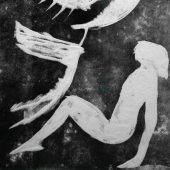Mustafa Al Hallaj
- Country: Palestine
- Exhibitions:
- Night was paper and we were ink
- On This Land
Born 1938, Jaffa, Palestine
Died 2002 Damascus, Syria
By Isabella Ellaheh Hughes
Best known for his graphic arts, Palestinian artist Mustafa Al Hallaj moved with his family to Damascus in 1948 when he was forced to leave his homeland. His Palestinian heritage was a central point of inspiration and much of his work combines symbols, folklore, and references from Palestinian history. In his 1993 woodcut print Sabra and Shatila, Al Hallaj references one of the worst atrocities in Arab contemporary history. In 1982, under the watch of the Israeli army, up to 3500 Palestinian and Lebanese civilians were brutally murdered over the course of a day and a half by Christian Lebanese militiamen allied to Israel in the refugee camp of Shatila and the adjacent neighborhood of Sabra in Beirut. Al Hallaj emotively depicts the silhouette of a woman on the ground encountering a winged angel, the sun and moon. Al Hallaj was a founding member of the trade union committee of the General Union of Palestinian Writers and Journalists and helped establish an art gallery dedicated to Naji al-Ali in Damascus. He died in 2003 after rescuing his famous work Self-portrait as Man, God, the Devil from an electrical fire in his home studio, by running in to save other works. His work has been exhibited globally and is held in numerous private and public collections around the world.
Died 2002 Damascus, Syria
By Isabella Ellaheh Hughes
Best known for his graphic arts, Palestinian artist Mustafa Al Hallaj moved with his family to Damascus in 1948 when he was forced to leave his homeland. His Palestinian heritage was a central point of inspiration and much of his work combines symbols, folklore, and references from Palestinian history. In his 1993 woodcut print Sabra and Shatila, Al Hallaj references one of the worst atrocities in Arab contemporary history. In 1982, under the watch of the Israeli army, up to 3500 Palestinian and Lebanese civilians were brutally murdered over the course of a day and a half by Christian Lebanese militiamen allied to Israel in the refugee camp of Shatila and the adjacent neighborhood of Sabra in Beirut. Al Hallaj emotively depicts the silhouette of a woman on the ground encountering a winged angel, the sun and moon. Al Hallaj was a founding member of the trade union committee of the General Union of Palestinian Writers and Journalists and helped establish an art gallery dedicated to Naji al-Ali in Damascus. He died in 2003 after rescuing his famous work Self-portrait as Man, God, the Devil from an electrical fire in his home studio, by running in to save other works. His work has been exhibited globally and is held in numerous private and public collections around the world.
Related artists by country
- Abdel Rahman Katanani
- Bashar Alhroub
- Jawad Al Malhi
- Jeffar Khaldi
- Laila Shawa
- Larissa Sansour
- Layan Shawabkeh
- Mona Hatoum
- Samia Halaby
- Shadi Habib Allah
- Steve Sabella
- Suleiman Mansour
- Tarek Al Ghoussein
- Jumana Manna
- Sharif Waked
- Paul Guiragossian
- Kamal Boullata
- Abdul Hay Mosallam Zarara
- Hazem Harb
- Khaled Jarrar
- Ahmad Nawash
- Asim Abu Shakra
- Khaled Hourani
- Tayseer Barakat
- Taysir Batniji
- Hani Zurob
- Shadi Alzaqzouq
- Kamel Moghani
- Yasser Dweik
- Ismail Shammout
- Jabra Ibrahim Jabra
- Maliheh Afnan
- Suha Shoman
- Vera Tamari
- Ufemia Rizk
- Ghassan Kanafani
- Jumana El Husseini
- Essa Grayeb
- Tammam Al-Akhal
- Samira Badran
- Abed Abedi
- Nabil Anani
- Ruba Salameh
- Samia Zaru
- Amjad Ghannam
- Juliana Seraphim
- Walid Abu Shaqra
- Zulfa Al Saadi
- Sophie Halaby
- Lydia Ata
- Emily Fanous Azar
- Nahil Bishara
- Faten Toubasi
- Samir Salameh
- Madj Abdel Hamid
- Amer Shomali
- Hassan Hourani
- Ahmad Kanaan
- Mohammed Bushnaq
- Ibrahim Hazimeh
- Mariam Farah Abu Nwarah
